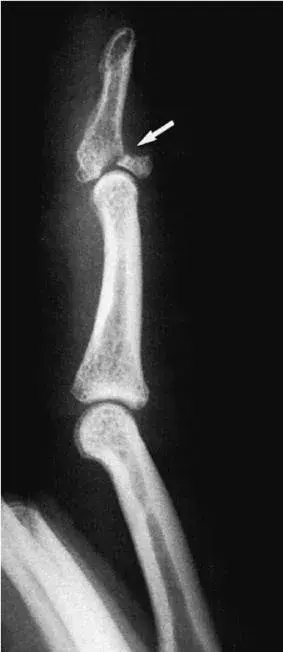Most Missed Question in EM Exam Prep — Lumbar Spine Anatomy
A lumbar L4–5 disc herniation typically compresses the L5 nerve root, producing weakness in great-toe dorsiflexion while leaving the patellar reflex and plantar sensation intact. Recognizing this myotomal pattern helps differentiate L5 radiculopathy from neighboring root lesions and avoid distractors based on reflex or sensory changes.
In a patient with the pathophysiologic process seen in the image below (a posterior view of L3, L4, L5, with a disc herniation at the L4-L5 level), which of the following would you expect to find on clinical examination?

Answer Options:
- decreased strength with great toe extension
- lack of a patellar reflex
- decreased sensation over the lateral plantar surface of the foot
- negative straight leg raise test
The correct answer is #1, decreased strength with great toe extension. While not a ‘test trick’ as such, the use of mixed modality distractors like this is very common on exam questions. The distractors here have you looking at reflex and sensation.
Watch for those types of questions that have distractors that seem to have indications all over the place. Unlike guideline depth of knowledge questions, mixed-mode distractors are often diagnostic depth of knowledge.
Why This Question Is Often Missed
- Myotome vs. Reflex confusion: Test-takers sometimes mistake a deep tendon reflex (patellar, Achilles) for a myotomal strength test (e.g. great-toe dorsiflexion), leading them to choose “patellar reflex” changes.
- Dermatome–myotome overlap: The L5 root supplies both cutaneous (dorsum of foot) and motor (toe extension) functions; students may grab the wrong sensory area (e.g. plantar versus dorsal foot).
What the Distractors Indicate
| Option | What It Tests / Implies | Why It’s Wrong Here |
|---|---|---|
| Lack of a patellar reflex | L4 nerve-root dysfunction | Patellar reflex is L3–L4; an L4-5 herniation compresses L5, so the patellar reflex is preserved. |
| Decreased sensation over the lateral plantar surface of the foot | S1 dermatome function | Lateral plantar surface is S1; an L5 root lesion spares S1 sensation. |
| Negative straight leg raise test | Absence of nerve-root irritation | A herniated L4–5 compressing L5 usually produces a positive straight-leg–raise. |
| Decreased strength with great toe extension | L5 myotome (dorsiflexion of the hallux) | Correct: L5 root compression → weakness of great-toe (and foot) dorsiflexion. |
High-Yield Pearl
L4–5 disc herniation → L5 root → weak great-toe dorsiflexion; patellar and Achilles reflexes remain normal.
Core Learning Objectives
- Correlate lumbar disc-herniation levels with specific myotomal and dermatomal deficits.
- Distinguish between myotome (strength), dermatome (sensation), and reflex testing in lumbosacral radiculopathies.
The “Test Trick” at Play
This item uses mixed-modality distractors, blending reflex, strength, and sensory choices to lure you away from the correct myotomal deficit. Recognize that strength testing (great-toe dorsiflexion) is the key to identifying an L5 root lesion, whereas patellar/Achilles reflexes and plantar sensation target adjacent roots.
Additional Emergency Medicine Practice Questions and Remediation
Emergency Medicine Practice Question 1
A 48-year-old construction worker has an MRI showing a central L3–4 disc herniation. On exam you’d expect all of the following except:
A. Weak hip flexion
B. Decreased patellar reflex
C. Numbness over the medial knee
D. Weak ankle dorsiflexion
Answer and Remediation
- If you chose A (Correct): Correct response! L3–4 → L4 root; hip flexion (L2–L3) is spared.
- If you chose B: Review: L4 root compression does cause a decreased patellar reflex (L3–L4).
- If you chose C: Review: Medial knee sensation is L4 dermatome, so it’s diminished here.
- If you chose D: Review: Ankle dorsiflexion (L4–L5), particularly tibialis anterior (L4), is weakened in L4 root lesions.
Emergency Medicine Practice Question 2
A patient with an S1 nerve-root impingement will most likely have:
A. Inverted plantar reflex
B. Weak great-toe extension
C. Decreased Achilles reflex
D. Numbness over the medial thigh
Answer and Remediation
- If you chose C (Correct): Correct response! S1 root lesion → diminished Achilles reflex.
- If you chose A: Review: Plantar (Babinski) tests UMN; S1 radiculopathy spares this.
- If you chose B: Review: Great-toe extension is L5 myotome, not S1.
- If you chose D: Review: Medial thigh (L2–L3 dermatome) isn’t affected by S1 compression.
Emergency Medicine Practice Question 3
A slipped L5–S1 disc herniation would most likely spare which of the following?
A. Hip abduction
B. Ankle plantarflexion
C. Big-toe dorsiflexion
D. Lateral foot sensation
Answer and Remediation
- If you chose A (Correct): Correct response! Hip abduction is L4–L5 (superior gluteal nerve), spared by L5–S1.
- If you chose B: Review: S1 lesion weakens ankle plantarflexion.
- If you chose C: Review: Big-toe dorsiflexion is L5, partially affected by L5–S1.
- If you chose D: Review: Lateral foot sensation is S1 dermatome, lost in S1 root compression.
Emergency Medicine Practice Question 4
A 52‑year‑old woman presents with low back and groin pain. MRI shows a central L2–3 disc herniation. On examination, you’d most likely find:
A. Decreased hip flexion strength
B. Decreased great‑toe dorsiflexion
C. Diminished Achilles reflex
D. Numbness over the lateral foot
Answer and Remediation
- If you chose A (Correct): Correct response! The L3 root contributes to hip flexion (iliopsoas), so an L2–3 herniation weakens hip flexion.
- If you chose B: Review: Great‑toe dorsiflexion is an L5 myotome, not affected by an L2–3 lesion.
- If you chose C: Review: The Achilles reflex is S1; an L2–3 lesion spares S1.
- If you chose D: Review: Lateral foot sensation is S1 dermatome, not L3.
Emergency Medicine Practice Question 5
A 45‑year‑old runner has an MRI showing a right paracentral L5–S1 disc herniation. On sensory testing, you would expect:
A. Decreased sensation over the dorsum of the foot
B. Decreased sensation over the medial calf
C. Decreased sensation over the lateral foot
D. Decreased sensation over the medial thigh
Answer and Remediation
- If you chose C (Correct): Correct response! The S1 dermatome covers the lateral foot, so S1 compression causes lateral–foot sensory loss.
- If you chose A: Review: Dorsum of the foot is L5 dermatome.
- If you chose B: Review: Medial calf sensation is L4–L5 territory.
- If you chose D: Review: Medial thigh sensation is L2–L3 dermatome.
Mini Case Discussion Prompt
Compare the clinical exam findings of L4 vs. L5 vs. S1 radiculopathies in terms of myotome, dermatome, and reflex involvement, and discuss how this guides surgical vs. conservative management decisions.
This question appears in Med-Challenger Emergency Medicine Review with CME
Try for free and save. Ace your exams and meet your CME/MOC requirements for just $35 a month!
No matter your program, no matter the size, Med-Challenger for Groups and Institutions can better prepare your program or group, fulfill industry requirements, and increase test scores.








